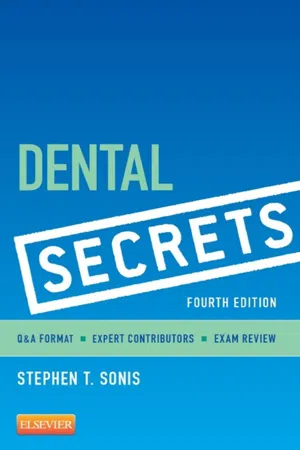
- 368 pages
- English
- ePUB (mobile friendly)
- Available on iOS & Android
Dental Secrets
About this book
Offering practical tips and expert answers to topics in dentistry and oral medicine, Dental Secrets, 4th Edition provides an ideal preparation tool for exams, clinical rotations, and board certification. A concise, illustrated Q&A format covers key areas such as oral pathology and radiology, periodontology, endodontics, restorative dentistry, prosthodontics, orthodontics, infection control, and oral and maxillofacial surgery. Written by Stephen Sonis and a team of expert contributors, this mini-reference makes it easier to prepare for real-world clinical scenarios and review for the NBDE and other certification exams.- Over 2, 000 questions include concise answers for core topics in dentistry and oral medicine, providing valuable pearls, tips, memory aids, and 'secrets.'- Question-and-answer format makes this the perfect review tool for certification exams, a clinical refresher, or a quick reference guide.- Over 100 illustrations, tables, and bulleted lists highlight key information.- Expert contributors share practical tips, answers, and secrets on safe and effective dentistry practice.- UPDATED content includes the latest advances in the science and practice of dentistry, including CBCT, CAMBRA, new methods for diagnosing caries, mini dental implants, platform switching, early childhood caries (ECC), and more.- NEW illustrations provide high-quality dental images.- NEW two-color design highlights questions and other features such as tables, boxes, and bulleted lists, making it easier to find information.- ThreeNEW contributors — Nathaniel Treister, Jennifer Frustino, and David Kim — provide fresh insight in the chapters on treatment planning and oral diagnosis, periodontology, restorative dentistry, and prosthodontics.
Frequently asked questions
- Essential is ideal for learners and professionals who enjoy exploring a wide range of subjects. Access the Essential Library with 800,000+ trusted titles and best-sellers across business, personal growth, and the humanities. Includes unlimited reading time and Standard Read Aloud voice.
- Complete: Perfect for advanced learners and researchers needing full, unrestricted access. Unlock 1.4M+ books across hundreds of subjects, including academic and specialized titles. The Complete Plan also includes advanced features like Premium Read Aloud and Research Assistant.
Please note we cannot support devices running on iOS 13 and Android 7 or earlier. Learn more about using the app.
Chapter 1: Patient Management
Case Examples
Patient Interview
- 1. What is the basic goal of the initial patient interview?
- 2. What are the major sources of clinical data derived during the interview?
- 3. What are the common determinants of a patient’s presenting behavior?
-
- 1. The patient’s perception and interpretation of the present situation (the reality or view of the present illness)
- 2. The patient’s past experiences or personal history
- 3. The patient’s personality and overall view of life
- 4. Discuss the insecurities that patients might encounter while relating their personal histories.
- 5. How can one effectively deal with the patient’s insecurities?
- 6. Why is it important for dentists to be aware of their own feelings when dealing with patients?
- 7. List two strategies for the initial patient interview.
-
- 1. During the verbal exchange with the patient, all the elements of the medical and dental history relevant to treating the patient’s dental needs should be elicited.
- 2. In the nonverbal exchange between the patient and dentist, the dentist gathers cues from the patient’s mannerisms while conveying an empathetic attitude.
- 8. What are the majo...
Table of contents
- Cover image
- Title page
- Table of Contents
- Copyright
- Dedication
- Preface to the 4th Edition
- Contributors
- Chapter 1. Patient Management: The Dentist-Patient Relationship
- Chapter 2. Treatment Planning and Oral Diagnosis
- Chapter 3. Management of Medically Compromised Patients
- Chapter 4. Oral Pathology
- Chapter 5. Oral Radiology
- Chapter 6. Periodontology
- Chapter 7. Endodontics
- Chapter 8. Restorative Dentistry
- Chapter 9. Prosthodontics
- Chapter 10. Pediatric Dentistry and Orthodontics
- Chapter 11. Oral and Maxillofacial Surgery
- Chapter 12. Infection and Hazard Controls
- Chapter 13. Dental Public Health
- Chapter 14. Legal Issues and Ethics
- Index